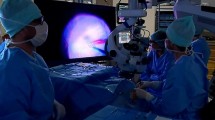Abstract
Purposes
To compare surgeons’ opinions regarding idiopathic full-thickness macular hole (MH) surgery by using traditional microscopy and three-dimensional (3-D) visualization system. To analyze the required time for pars plana vitrectomy (PPV) and for internal limiting membrane (ILM) rhexis by using both visualization methods. To evaluate anatomical surgical results.
Methods
Four surgeons (surgeon 1, fellows 1, 2, 3) performed the total of 40 surgeries for treating MHs. Each one performed 10 surgeries (5 with traditional microscopy and 5 with 3-D visualization). The completion time for PPV and ILM rhexis was determined by using both methods. Ergonomics, educational value, image sharpness, depth perception, field of view and technical skills were analyzed through answering a questionnaire.
Results
Forty patients were included in the study. The MH size for surgeon 1, fellows 1, 2 and 3 groups, individually, ranged from 237 to 602 μm; 228 to 590 μm, 271 to 611 μm and 289 to 600 μm, respectively. In the 3-D and in the traditional microscopy subgroups (which includes all 4 physicians on the use of one or the other method), the MH size ranged from 228 to 602 μm and 237 to 611 μm, respectively. Comparisons between the average time for full PPV and ILM rhexis by using the two methods were non-significant, neither in each individual case of 3-D surgery for each surgeon. Surgeon 1 had always been faster than his fellows. Depth perception was rated as similar for both methods. Field of view and educational values were rated as superior when using the 3-D system. Image resolution and ergonomics were rated as superior when using traditional microscopy. Technical skills strongly tended toward ‘superiority’ when using traditional microscopy. Thirty-six (90%) full-thickness MHs were successfully closed with one surgery.
Conclusion
The 3-D system for MH surgery had a short learning curve and was a refined educational tool, when used with reduced illumination and precise focus. Concerning MH surgery, heads-up method was similar to traditional microscopy regarding length of time and anatomical surgical results. Heads-up surgery may become a new pattern for ophthalmic surgery as ongoing improvements are applied.





Similar content being viewed by others
References
Allen CH, David WF, Jason H et al (2015) The case for 3-D Retina surgery. Retina Today 10(8):76–78
Eckardt C, Paulo EB (2016) Heads-up surgery for vitreoretinal procedures: an experimental and clinical study. Retina 36:137–147
Coppola M et al (2017) Heads-up 3D vision system for retinal detachment surgery. Int J Retina Vitreous 3:46
Rodrigues EB et al (2007) Vital dyes for chromovitrectomy. Curr Opin Ophthalmol 18:179–187
Rodrigues EB, Meyer CH, Kroll P (2005) Chromovitrectomy: a new field in vitreoretinal surgery. Graefes Arch Clin Exp Ophthalmol 243:291–293
Stem MS et al (2017) Heads-up 3-D visualization in complex vitreoretinal surgery. Retina Today 12(5):44–48
Charles S (2017) Getting specific about 3-D visualization. Retina Today 12(8):48–49
Berrocal M, Figueroa M, Packo K, Rizzo S (2016) A new way to see the big picture in a micro environment. Insert Retina Today 3:4–7
Yoshihiro Y (2016) Seeing the world through 3-d glasses. Retina Today 11(7):54–60
Mendez BM et al (2016) Heads-up 3D microscopy: an ergonomic and educational approach to microsurgery. Plast Reconstr Surg Glob Open 4:1–4
Weinstock RJ (2011) Operate with your head up. Cataract Refract Surg Today 8:66–74
Dhimitri KC, McGwin G, McNeal SF et al (2005) Symptoms of musculoskeletal disorders in ophthalmologists. Am J Ophthalmol 139:179–181
Charles S (2008) Illumination and phototoxicity issues in vitreoretinal surgery. Retina 28:1–4
Adam MK, Thornton S, Regillo CD et al (2017) Minimal endoillumination levels and display luminous emittance during three-dimensional heads-up vitreoretinal surgery. Retina 37:1746–1749
Acknowledgements
The authors have no financial interest in any aspect of this report.
Author information
Authors and Affiliations
Corresponding author
Rights and permissions
About this article
Cite this article
Palácios, R.M., Maia, A., Farah, M.E. et al. Learning curve of three-dimensional heads-up vitreoretinal surgery for treating macular holes: a prospective study. Int Ophthalmol 39, 2353–2359 (2019). https://doi.org/10.1007/s10792-019-01075-y
Received:
Accepted:
Published:
Issue Date:
DOI: https://doi.org/10.1007/s10792-019-01075-y




